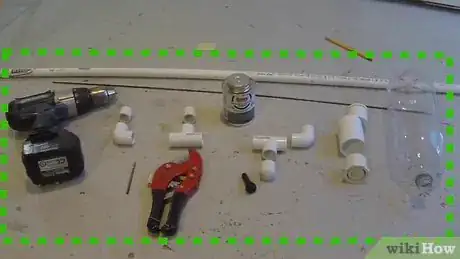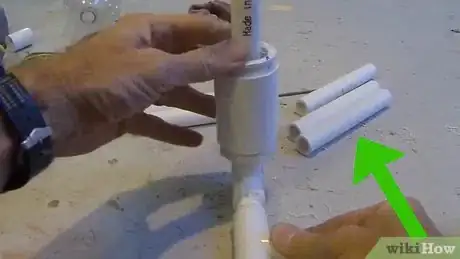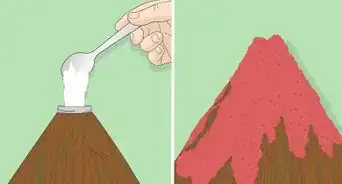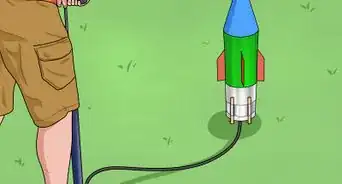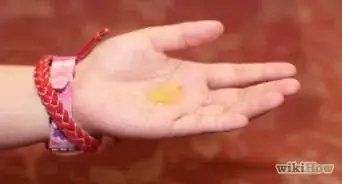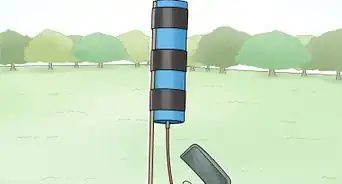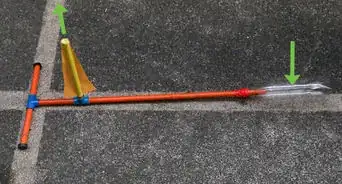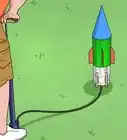X
This article was co-authored by wikiHow Staff. Our trained team of editors and researchers validate articles for accuracy and comprehensiveness. wikiHow's Content Management Team carefully monitors the work from our editorial staff to ensure that each article is backed by trusted research and meets our high quality standards.
There are 7 references cited in this article, which can be found at the bottom of the page.
This article has been viewed 130,521 times.
Learn more...
A bottle launcher usually uses pressurized air and water to shoot a bottle high into the air. Usually built with easily found supplies, this project is suitable for both fun and education, though it will take some handiness with PVC piping.
Steps
Method 1
Method 1 of 3:
Building the Launcher System
-
1Collect the materials and building supplies. Go to the hardware store and buy the materials you will need, listed below. You will also need a collection of tools, such as a hammer, electric drill, drill bits, a bike pump, and a hacksaw/PVC cutters, but most people will already have the equipment. You should buy:
- .453 rim hole tubeless tire valve (auto parts store)
- PVC cement
- 1/8" steel rod 24" long
- 2-liter soda bottle
- 6' of 1/2" Schedule 40 PVC pipe (all the following parts are Schedule 40 PVC)
- 1 1/4" x 1/2" Bushing
- 1 1/4" Coupling
- 1 1/4" x 1" Bushing
- 2 1/2" elbows
- 4 1/2" caps
- 3 1/2" t's
-
2Drill a hole into one of the 1/2" PVC caps using your 9/16" drill bit. Start with a thin, small pilot hole, then drill the big one. This hole needs to contain your valve, so if you're not using a .453" tube then you need a drill bit that will fit the valve snugly.Advertisement
-
3Pull the valve through the drilled hole so it is air-tight. You want the top of the valve (where you add air) to be sticking out of the top of the PVC cap. The "seat" of the valve should fit right in the cap.
-
4Place the top of the empty, capless soda bottle in the top of the 1/2 x 1" bushing. Note the wide plastic lip right where the screw top meets the bottle. You'll be using your steel rod to pin this lip down, keeping the bottle in place as it gains power. You can then pull the steel rod out of the bushing to let the rocket release.
- This lip must be at least a 1/4" below the top of the bushing.
-
5Cut the steel rod into a 10" piece, then bend your steel rod into a U shape roughly 1/3 inch wide. You want the ends of the steel rod to fit on the side of the bushing, as you will thread them through the bushing. Bend the 10" piece directly in half -- it should be perfect.
-
6Press the two ends of the rod into the side of the bushing, mark where they touch the meet the bottle cap, then drill two holes to thread the steel rod into the bushing. Use the bottle to make your height lines. Then use a sharpie to draw two horizontal lines on the top of the bushing to guide your drill. Remember -- you need to rod to cover the lip of the bottle and keep it in place. The rod acts a bit like a pull tab, holding the bottle down until you pull it out. The bend of the rod should be out to the side, with the ends inside the bushing.
- Start with a 3/32" bit to start the holes, then a 5/32" drill bit to cut them to size.
- Use your rod to poke through the holes and get out any hanging bits.
-
7Take the 1/2" x 1/4" bushing and carve out the stopper with a sharp knife or a Dremel tool. The smaller bushing needs to be thinned out on the inside so that the other bushing can slide right through. To do this, take a sharp knife and carve away the inside of the bushing so the whole thin is the same width.
-
8Cut a piece of 1/2" pipe to 12" long, then make a mark 2" from one of the ends. This is the final piece of your launch mechanism.
-
9Glue the 1/2" x 1/4" bushing (the one you carved out) so that it ends right at your 2" mark. Using PVC cement, glue the bushing to the 1/2" pipe, making it so the bottom of the bushing is right at the mark you made. There should be 10" of pipe remaining. The little stub will point out.
- The 1-1/4" bushing end should point to the larger end of the pipe.
-
10Glue and elbow onto the small "stub" pointing out from your bushing. Make sure you glue a nice, airtight joint everywhere you can.
-
11Glue the big PVC coupling to the other end of the bushing, the one already glued to the PVC rod. Slide the coupling onto the longer end of the PVC rod, then fit it into the back of the bushing. Make sure you glue it on well, so the joint is airtight.
-
12Glue the bushing with the launch pad holes drilled into the other end of this coupling. Make sure that the holes you cut are still visible above the coupling. By now, if you went from one end to the other, you would have:
- Elbow joint
- Smaller bushing
- PVC coupling
- Launch pad bushing
- 1/2 PVC pipe.
Advertisement
Method 2
Method 2 of 3:
Building the Frame
-
1Cut the remaining 1/2" pipe six identical 6-10" segments and one smaller 2-4" inch piece. These exact specifications are not quite as important as the others, so use what you have left however it fits. The stand is made of one long piece of PVC pip (1/2"), and three smaller legs extending off the sides, flat on the ground, to keep everything standing up.
-
2Attach the 2" piece of PVC and a T-joint to the elbow at the end of the launcher system. You want the actual launcher (the bushing with the holes in it) pointed straight up to the sky. Glue in the small piece to the elbow, then attach a T-joint to that small piece of pipe.
-
3Glue a piece of PVC into the T-joint, perpendicular to the launcher system for support. This is your first support foot. Glue it in, then glue on an air-tight cap over the end to keep pressure up.
-
4Extend the frame further away from the launcher with more 2 more PVC pipes, 2 more feet, and two more T-joints. Make sure that this T-joint points the opposite direction as the other one for maximum support. As always, glue everything air-tight and glue on an end cap to prevent air leakage.
-
5Add one more PVC pipe to extend the frame, then glue the final elbow joint at the end, pointing up. The whole thing makes a small U-shape, with the two feet sticking perpendicular away from the frame.
-
6Glue the valve piece into the elbow joint, pointing up. You may need one more small piece of PVC to connect the elbow joint to the cap with the valve. Remember -- you can never glue it too air-tight!
Advertisement
Method 3
Method 3 of 3:
Launching Rockets
-
1Attach a bike pump to the exposed valve. This is how you increase the air pressure in the bottle. Each pump adds air to an already tight, pressurized system. With nowhere to go, this pressure builds up in the bottle and propels it when freed.
-
2Fill the bottle 2/3 of the way with water and slide it onto your exposed PVC pipe. The water will be your "fuel" as it comes under pressure.
-
3Slide the steel wire into the drilled holes into your bushing to hold the bottle down. Use the U-shaped wire to lock the bottle in place. It will want to move as pressure builds up.
-
4Make sure the bottle points in a safe, open direction, then start pumping to roughly 80psi. If you don't have a pressure gauge, just pumping for 15-25 seconds would work out just fine. Make sure that you are in a wide-open area.
-
5Release the steel wire to launch the rocket. Make sure your head and hands are away from the launcher and bottle -- it will really fly if you're not careful.
-
6Understand what is going on. As the air pressurizes the bottle and launcher and is then released it creates an action force blowing the escaping air down. In turn this creates an equal and opposite force for the bottle to go in the other direction, upwards! This is because of Newton's Third Law of Motion. Increasing the pressure inside the bottle increased the thrust (Newton's Second Law of Motion). The water is inside the bottle to add velocity, as the water is heavier than the air so as the air pushes the water out first on launch your bottle will fly further.[1]
Advertisement
Community Q&A
-
QuestionWhat is the maximum pressure that can be created inside the bottle launcher to gain maximum range within safety limits?
 Community AnswerThe soda bottles are technically made to withstand 100 psi. Therefore, to be on the safe side, you should not do much more than 50 psi.
Community AnswerThe soda bottles are technically made to withstand 100 psi. Therefore, to be on the safe side, you should not do much more than 50 psi. -
QuestionWhat do I do if my bottle launcher leaks?
 Community AnswerDunk the launcher in a bucket of soapy water and squeeze it. Bubbles will appear wherever the leak is, and you can then patch it using something like duct tape.
Community AnswerDunk the launcher in a bucket of soapy water and squeeze it. Bubbles will appear wherever the leak is, and you can then patch it using something like duct tape. -
QuestionWhat seals the base of the bottle while you pressurize it by pumping?
 Community AnswerYou could wrap the tube that is inserted into the bottle with electrical tape instead of trying to hold the bottle on with a wire. The friction between the tape and the bottle should be enough to hold the bottle in place and create a seal while you pump the air in.
Community AnswerYou could wrap the tube that is inserted into the bottle with electrical tape instead of trying to hold the bottle on with a wire. The friction between the tape and the bottle should be enough to hold the bottle in place and create a seal while you pump the air in.
Advertisement
Warnings
- Do not shoot at low angles, the risk of hitting something is far greater and your rocket will not go as far. Also, there is danger from the rocket’s “blowback”.⧼thumbs_response⧽
- Higher pressures result in a greater risk of explosions and injury.⧼thumbs_response⧽
- Stay at least 4 feet (1.2 m) back from the pressurized rocket.⧼thumbs_response⧽
- Don’t’ look down at the rocket during or after pressurizing the bottle.⧼thumbs_response⧽
- Don’t use your rocket in a parking lot, you will damage a car and be financially liable.⧼thumbs_response⧽
- Do not aim your rocket at people, animals or buildings of any kind.⧼thumbs_response⧽
Advertisement
References
- ↑ https://www.youtube.com/watch?v=gyOzvqmUs4c
- Videos provided by iCreatables
- http://www.reachoutmichigan.org/funexperiments/quick/scigems/launcher.html - Using aluminum
- http://stanpope.net/rocket.html - Another design
- www.cse.ucsc.edu/~karplus/abe/soda-bottle-rocket.pdf - Another more complex design
- http://en.wikipedia.org/wiki/Schrader_valve - All about Schrader valves
- http://csep10.phys.utk.edu/astr161/lect/history/newton3laws.html - Newton’s Three Laws of Motion
About This Article
Advertisement
